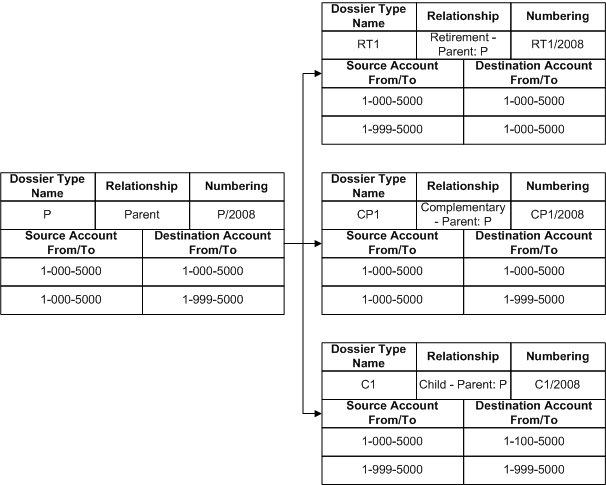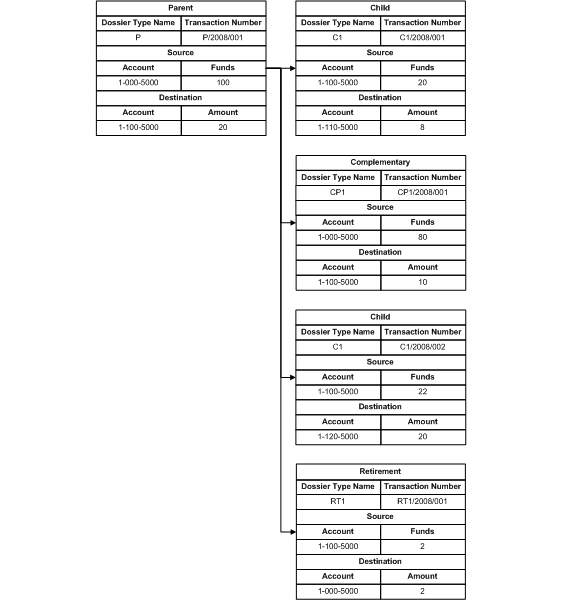Dossier Process
Definition
In the public sector, the budgeting process involves various levels of government that determine the amount to be spent on goods and services and when the money is available to spend. Dossier provides the accounting processes required to support this budgeting process.
Overview
The public sector uses dossiers to allocate accrual and payment budget funds to a lower level of detail. For example, a dossier could be raised to register parliament’s decision to allocate funds to be committed to the Ministry of Education for constructing new schools. The Ministry of Education meets to determine a more specific use of the commitment funds and additional dossiers are used to allocate the funds for more specific purposes. Therefore, a dossier is either a balanced or unbalanced budget journal transfer.
The dossiers follow strict numbering regulations and a hierarchical approval process before the transfer of funds can be processed.
To meet the needs of the public sector requirements for dossier, a structure of dossier types is required to enable a strict control system to be set up as shown in the table below.
| Dossier Types | Description |
|---|---|
| Parent | Parent dossiers relate to the parliamentary vote, that is the initial assignment of budget. |
| Child | Child dossiers enable various required levels of budget allocation to be created. |
| Complementary | Complementary dossiers enable additional funds to be allocated to or funds to be subtracted from the related dossier. |
| Retirement | Retirement dossiers allow end-of-year reallocation of unused budget amounts, enabling the amounts to be returned to parent dossiers to be reassigned for next year. |
Dossier acts as a control system on the budgets allocated through the standard budget allocation within General Ledger, using predefined French public sector rules and numbering. Dossier maintenance is the transfer of funds within the defined budget structure.
Dossier Process Flow Diagram
The diagram below shows the dossier process flow, as described in the accompanying text.

Dossier Processes
Set Up Approval Hierarchy
Users can set up a hierarchical structure for the approval of dossier maintenance transactions. Users can define a different hierarchy for each dossier type.
Within each hierarchical structure there must be at least one position defined as shown in the following table.
| Hierarchy 1 |
|---|
| Director |
| Manager |
| Clerk |
Each person in the hierarchy receives a notification requesting action to be taken regarding the dossier transaction; for example, approve or reject the transaction. In the example, if the Clerk inputs the dossier transaction, the Manager receives the first notification. If the dossier transaction is approved by the Manager, the Director receives a notification to approve. If rejected, the transaction originator receives a workflow notification.
Set Up General Ledger Budget
Users must set up a standard general ledger budget, a budget organization, and post the initial budget journal in order to operate a set of dossiers.
The dossier system operates as a controlling mechanism for the transfer of general ledger budget amounts within a specified range of accounts.
Defining a Budget
Defining and entering budgets are standard general ledger functions. An example of the budget process is as follows:
-
Define a budget.
-
Enter the name; for example, Dossier - Ed.
-
Enter a description; for example, Dossier for the ministry of education.
-
Set the budget status to Open.
-
Set the required journals to Yes.
-
Enter the first and last budget periods.
Defining a Budget Organization
Budget organizations are defined as follows:
-
Enter the name of the organization.
-
Enter a description; for example, Dossier organization.
-
Enter the account range; for example, 1-0-6001-000 to 1-0-6010-010.
-
Enter the funding budget; for example, Dossier - Ed.
Entering a Budget Journal
-
Enter the budget organization; for example, Dossier Org.
-
Enter a budget; for example, Dossier - Ed.
-
Enter the accounting period; for example, Jan - 08.
-
Enter the budget worksheet account; for example, 1- 0-6001-000.
-
Enter a worksheet amount; for example, $40M.
For information on setting up and entering budgets, see Enter Budget Amounts Window, Oracle General Ledger User Guide.
Set Up Dossier Numbering
Users must set up a numbering sequence for each dossier to be created. This number prefixes a sequential count of all transactions entered against the individual dossier.
An example of dossier numbering is shown in the following table.
| Sequence | Description |
|---|---|
| Prefix | prefix to the number, for example, ME |
| Number | automatically generated sequential number, for example, 1 |
| Delimiter | delimits the number, for example, ’-’ |
| Fiscal year | 4 digit number, for example, 2008 |
The example shown in Dossier Numbering table creates the dossier number ME1-2008. All transactions relating to that dossier are then sequentially numbered, for example, ME1-2008-1, ME1-2008-2, and so on.
Set Up Dossier Types
The next stage is to define the dossier type. This process follows the standard hierarchical structure where children can have children and so on. For each dossier type in the structure, users must create a unique dossier numbering entry. The information required to create a dossier is as follows:
-
dossier name
-
relationship
The type of dossier must be selected, for example, parent.
-
related dossier type
The related dossier must be defined for all except the parent dossier, for example, the name of the parent dossier.
-
numbering scheme
The defined numbering for the dossier must be selected.
-
approval hierarchy
The HR position hierarchy must be selected.
-
source information
Users can specify the budget organization, budget, and account code ranges used to supply the source funding for the dossier.
-
destination information
Users can specify the budget organization, budget, and account code ranges used to define the destination accounts for the dossier transfer of funds.
Maintain Dossiers
Maintaining dossiers is the process of creating budget transfers to allocate budget funds to the appropriate accounts and years. The information required to create a dossier transaction is as follows:
-
A dossier type must be selected.
-
A dossier name and description must be defined.
Users must define a unique reference and description for the maintenance transaction, for example, School R-17 Reading.
-
A parent transaction number must be selected for child, complementary, and retirement dossiers.
-
A transaction number must be allocated, for example, ME1-2008-6.
Note: The transaction number is automatically allocated.
Available source funds are displayed.
-
Amount to be allocated to the destination accounts is selected.
-
Funds must be checked and reserved.
-
Transaction must be sent for approval.
When approved, the budget funds are transferred to the selected budget accounts.
Dossier Relationships
Parent Dossier
Parent dossiers consist of sources and destinations set up by users. A parent dossier is the top level of the dossier. The Dossier Types diagram and the Dossier Maintenance diagram, show examples of creating and maintaining a parent dossier as follows:
-
set up the dossier type
-
first dossier transaction P/2008/001 moves 20 to cost center 100
The dossier type is set up as follows:
-
budget of 100 set up in January 2008 in account number 1-000-5000
-
destination cost center is 100
Child Dossier
A child dossier is related to a parent dossier. The source of the child dossier type must be the destination of the parent dossier type. The destination is selected from the range assigned to the child dossier type. The Dossier Types diagram and the Dossier Maintenance diagram show examples of creating and maintaining a child dossier as follows:
-
set up the dossier type
-
transaction moves 8 to cost center 110 by first selecting the associated parent transaction and then moving the funds to cost center 110
The dossier type is set up as follows:
-
source range must be the same as parent’s destination
-
destination cost center range is 100 to 199
Complementary Dossier
Complementary dossiers are created if additional funds need to be added to a dossier. Complementary dossiers can be related to a parent or child dossier. Both sources and destinations are automatically populated from the related dossier. The Dossier Types diagram and the Dossier Maintenance diagram show examples of creating and maintaining a complementary dossier as follows:
-
dossier setup
-
dossier maintenance transaction, moving 10 to cost center 100 by first selecting the associated parent transaction and then moving 10 from the funds
The dossier type is set up as follows:
-
this dossier is the transfer of additional budget funds added to the budget
-
destination range must be the same as the parent’s destination
-
additional budget of 10 in January 2008 in account number 1-000-5000
Retirement Dossier
At the end of the year all unused destination funds are usually transferred back to the sources using retirement dossiers. Retirement dossiers can be related to parent or child dossiers. Related dossiers’ destinations are populated as the source of the retirement dossier and the source of the related dossier becomes the destination of the retirement dossier. The Dossier Types diagram, and the Dossier Maintenance diagram, show examples of creating and maintaining a retirement dossier as follows:
-
dossier maintenance transaction, retiring 2 by first selecting the associated parent transaction and then moving 2 from the funds
The dossier type is set up as follows:
-
this dossier is the transfer of unallocated budget funds back to a central budget
-
source range must be the same as the parent’s destination
-
destination range must be same as parent’s source
-
final fund of 2 remains in January 2008 in account number 1-100-5000 and is returned to the original account number 1-000-5000
-
when retiring a dossier, the entire source amount is transferred by default but users can manually adjust the amount to be transferred. Funds can only be checked at individual account level.
Dossier Type Setup and Maintenance Diagrams
The diagram below shows the dossier type setup for the parent, child, retirement, and complementary dossiers.

The diagram below shows an example of how dossiers are maintained.
